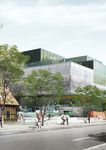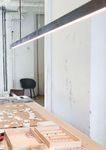DANISH DESIGN CENTRE STRATEGY 2016-2018 - Dansk Design Center
←
→
Page content transcription
If your browser does not render page correctly, please read the page content below
PREFACE
Denmark is a leading design nation with a strong design history
that is admired around the world. Since it was founded in 1978,
the Danish Design Centre (DDC) has been respectful of this
history. In recent years, the organisation has undergone many
changes. Our focus has shifted from increasing the awareness
of Danish design in a broad sense to increasing awareness of
design as a competitive parameter and, more recently, to
focusing on the use of design as a driver of innovation and
development in companies and society at large. The DDC
understands the broad scope, variation and diversity that
characterises design as a profession and as a discipline.
Therefore, the DDC is dedicated
to promoting the use of design
in business and industry, hel-
ping to professionalise the
design industry and documen-
ting, promoting and branding
Danish design in Denmark and
abroad.
Thus, the DDC’s work is clearly tied in with in the current
agenda for Danish business, innovation, education, export and
cultural policies.
Today, there is widespread awareness in Danish business and
industry that the use of design contributes to value creation in
companies. Many companies are already using design
methods in their innovation activities. Nevertheless, many
companies have an untapped growth potential that the use of
design could help them tap into.
2The DDC’s new strategy is rooted in history and in the qualities that
Danish design stands for, but it is also oriented towards the future.
New consumption patterns, new markets and new demands on
services and products mean new possibilities for Danish companies
but also the risk of being rendered irrelevant by the global compe-
tition. In this climate, the ability of designers to translate new trends
and technologies into solutions that are attractive, functional and
meaningful to the users becomes a crucial competitive factor. In the
coming years, the DDC will be conducting systematic experiments
with design-based value creation in companies and sharing the
resulting knowledge.
The DDC has a vision of contribu-
ting to making design one of the
three most important positions of
strength for Danish companies.
The DDC operates in a complex environment at the intersection of
business and industry, the design profession, education and
research institutions and public institutions. The DDC has high
ambitions but also a sense of humility and a clear understanding that
the task of increasing companies’ use of design can only be addres-
sed in open partnerships. The DDC’s ambitions have to be translated
into concrete actions and initiatives that make sense to companies
throughout the country.
The DDC is now building a new organisation – an organisation that
business and industry, the design profession and other stakeholders
can be proud of and draw inspiration from. Correspondingly, the
strategy is deliberately ambitious, open and innovative. Therefore,
the strategy is also intended as an invitation to the DDC’s
stakeholders to engage in a dialogue about our work.
Lars Mikkelgaard-Jensen Christian Bason
Chairman of the Board Chief Executive
3INTRODUCTION
This strategy was formulated in a close dialogue involving the DDC’s
board, leadership, staff and other stakeholders. The strategy defines
the direction for the DDC in the coming years, with the relocation to
the BLOX complex in early 2018 as a natural milestone and an occasion
to revisit and renew the strategy.
4THE STRATEGY IS STRUCTED
AROUND FIVE KEY QUESTIONS
Vision
Where does the DDC want to go?
Mission
What sort of value does the DDC
create, for whom, and where?
Activities
What does the DDC deliver, and in
what ways?
Competences
What capabilities should the DDC
have?
Organisation
How should the DDC be led and
managed?
Together, the answers to these questions make up the DDCs strategy.
5VISION
WHERE DOES THE DDC WANT TO GO?
Global competition and rapid technological developments are putting
companies under pressure to create new innovative products, services
and solutions. The companies’ ability to understand not only what is
technologically feasible but also what is valuable and helpful to their
clients and end-users is crucial to their competitiveness.
It is the DDC’s vision to help make
design one of the three main
positions of strength for Danish
companies.
Good design contributes to competitive products and solutions.
Designers place the client centre stage, and designers are able to
translate new insights into concepts and concrete solutions that provide
value to their clients and end-users. A number of Danish and interna-
tional studies, including studies conducted by the Danish Business
Authority and by the Design Management Institute, have found a
significant correlation between companies’ use of design and their value
creation and have documented that so-called ‘design-based’ companies
outperform other companies.
6MISSION
WHAT SORT OF VALUE DOES
THE DDC CREATE?
As Denmark’s national design centre, it is...
the DDC’s mission to promote the
use of design in business and
industry, to help professionalise
the design industry and to docu-
ment, promote and brand Danish
design in Denmark and abroad.
In other words, the DDC aims to ensure the best possible meeting
between the supply and demand sides in the design field.
On the demand side, the DDC helps to mature companies to enable
them to use design more strategically and thus increase the value of
the products or services they provide.
On the supply side, the DDC helps to identify and develop market
potentials for Danish design companies and to strengthen the
competences design companies need in order to tap into these
market potentials.
The DDC’s key approach in this encounter is systematic
experimentation with design-based value creation in companies.
8DEMAND
business and industry
at large
Systematic experiments
with design-based value
creation in companies
SUPPLY
design competences
Figure 1. The DDC links the demand and supply sides of design. 9THE DDC’S PLATFORMS
The DDCs mission is reflected in a number of platforms (strategic focus
areas). New platforms will be established as a result of changes in:
The context
Political, economic, social, technological or societal developments
that impact the companies’ underlying conditions and long-term
growth potentials in...
The market
Specific market potentials. This may include new technological
opportunities, physical products, services, consumption patterns, new
production forms, new business models or other factors. These market
changes also provide the basis for a significant …
Business potential associated with using design
How can design create value on a given (changing) market? For
example, what roles does design play in relation to new production
forms and business models, and what competences do designers
need?
Platforms are established and organised to facilitate close
collaboration with the DDC’s stakeholders. The selection of platforms
is determined on the basis of agendas that are important to several of
the DDC’s main stakeholders, including the members of Design
Society and BLOX, the initiative for architecture, construction, urban
development and design. Another consideration is a clear focus on
the chances of ensuring co-funding from companies, foundations, the
public sector, the European Union etc. The platforms serve as the basis
of the DDC’s development and scaling of initiatives and programmes.
In the coming years, the DDC is going to focus on a portfolio of five
platforms. Depending on the DDC’s capacity and developments in the
context, the market and the business potential associated with the use
of design, this focus may be modified and/or expanded.
10DESIGN-DRIVEN BUSINESS MODELS
demand
DESIGN DESIGN DESIGN
CITIES FUTURE HEALTH
FABRICATION
DESIGN DIMENSIONS
supply
Figure 2. DDC platforms 2016-2018. 11PLATFORM
DESIGN-DRIVEN BUSINESS MODELS
#BizModel
Increasingly, companies need to be able to grasp and act on new
opportunities rapidly. New disruptive business models and markets
provide new opportunities, as exemplified by Airbnb, Endomondo
and Podio. Sharing and circular are examples of concepts that
companies need to integrate in the way they do business in order to
be able to cooperate with engaged consumers on new business
models, revitalising the notion of ‘buying and selling’. Design
methods and the use of design as a strategic tool has the capacity to
strengthen companies’ understanding of their clients and customers
and thus their ability to react quickly to new business opportunities
and strengthen their position on existing markets.
Design-driven business models is a development platform for
programmes aimed at boosting the demand of design in business and
industry at large, in part by promoting development in Danish design
agencies . The DDC will examine how companies and designers may
reshape their businesses in the middle of a transformative
technological development with changing consumer needs. One of
the outcomes of this platform is the Plus programme, which enhances
companies’ capacity for business development and innovation via
design methods, and the program Scaling by Design, which aims to
enhance the ability of Danish product design firms to scale on a
national and an international level.
12Photo: The DDC is hosting a workshop around the Scaling by Design initiative. 13
14
PLATFORM
DESIGNING FUTURE FABRICATION
#FutureFab
The production landscape is rapidly changing. Technologies such
as 3D-printers, laser-cutters and new user-friendly hardware and
software make it possible rapidly to transform ideas into tangible pro-
totypes. The new production conditions allow for the development
of efficient and flexible systems and innovative products that incor-
porate technology. In this field of possibilities, design can serve as a
key competence for developing systems and products that link tech-
nology with client needs. Designers know how to navigate and take
a needs-based approach in complex development processes, and
they have unique qualifications for qualifying, inspiring and handling
interdisciplinary innovation processes when industrial engineers,
technicians and mechanics cooperate on product development.
Technology also gives design companies access to manufacturing
technologies and enables new business models and an expansion of
the design field.
Future Fabrication is a development platform for programmes aimed
at improving Danish production companies’ capacity for added
growth and for creating more innovative and sustainable solutions.
In cooperation with industry, the platform develops specific pro-
grammes and projects aimed at helping Danish production compa-
nies use design methods and explore the role of the design profes-
sion in a new production paradigm.
1516 Foto: Seier & Seier, CC-BY
PLATFORM
DESIGNCITIES
#DesignCities
All over the world, cities are developed and expanded as a result of
increasing globalisation, growing urbanisation and the development
of new technologies. People’s needs and the challenges faced by
cities are developing at a similar, rapid pace. Future business models
for urban development are increasingly going to rely on open data
flows and new technologies and will be driven by clients’ and
citizens’ specific needs.
DesignCities is a development platform for programmes that uncover
and strengthen the role of design in urban development. With
DesignCities, the DDC aims to bring companies, citizens and public
organisations more closely together around a shared focus on
designing cities via new types of partnerships. These partnerships
explore the role of design and strengthen new business models for
companies to take part in future urban development. From a design
perspective, DesignCities explores the concepts of smart city and big
data as well as areas such as urban planning, architecture and
strategic urban development.
1718
PLATFORM
DESIGNHEALTH
#DesignHealth
The healthcare sector is rapidly changing, and a growing pressure on
resources requires us to find new ways to deliver and provide
healthcare services and improve efficiency. For example, the use of new
technology to automate standardised work tasks is going to present
dramatic challenges to both the market and the design of the tasks . At
the same time, digitisation and big data give rise to new business
opportunities. There is already a growing demand for holistic solutions
that integrate new technology and personalised data and, not least,
accommodate patient needs.
DesignHealth is a development platform for programmes that use
design as a value-creating facilitator to connect companies and the
healthcare sector in order to create new, scalable solutions that can be
exported. With this platform, the DDC aims to examine how design can
contribute to realising the commercial potential of using big data in
better and broader applications, making new healthcare technology
more user-friendly and intuitive and offering smooth and coherent paths
through the healthcare service. Another goal for the DDC is to help
co-develop and qualify design companies that have the potential to
enter this market.
19PLATFORM
DESIGN DIMENSIONS
#DesignDim
Design-added value to innovation and business development is
growing rapidly. A growing number of companies are involving
designers and using design methods, and there is growing recognition
of the value of design. Denmark has a unique design narrative and
perhaps a special Danish design DNA that matches current and future
market needs – not least internationally.
Design Dimensions is a development platform for programmes aimed at
strengthen and expand the supply of design aimed at companies. With
this platform, the DDC aims to promote the development of the design
field, including charting what characterises successful design compa-
nies, and what it will take for Danish design companies to expand, in a
national as well as an international context.
2021
ACTIVITIES
WHAT DOES THE DDC DELIVER,
AND IN WHAT WAYS?
The development, implementation and scaling of DDC activities
involve three key ingredients: experiments, learning and sharing.
These ingredients are the DDC’s DNA.
Photo:
22 Design a.m. at the DDC.EXPERIMENTS
The DDC plans and conducts systematic experiments with design-based value
creation in companies. The DDC has a design-driven approach to these
experiments. This means that methods for creative idea generation, prototyping,
visualisation, co-design etc. are a natural part of the DDC’s approach. The DDC’s
use of design methods to increase the use of design contributes to added
innovation capacity and ownership as well as a high degree of legitimacy with
target groups and stakeholders. The DDC always develops and plans systematic
experiments in close collaboration with companies, designers and other actors,
for example business promotion and innovation actors, educational institutions,
other actors in the innovation hub BLOX and the sister organisations in Design
Society.
LEARNING
The DDC harvests and documents the new knowledge and insights about the
companies’ use of design that are generated in the DDC’s programmes. In this
effort, the DDC relies on qualitative data and methods from anthropology,
ethnography and sociology as well as quantitative methods from the fields of
economics, statistics and political science. These learning-oriented activities are
conducted as an integrated part of the experiments that the DDC plans. The goal
is to ensure ongoing learning. that is scalable, and which can be used to enrich
the experiments. This new knowledge is translated into formats (e.g. case
descriptions, methods, management reports etc.) that can be made widely
available to all companies, stakeholders and political decision-makers.
SHARING
The DDC makes learning and insights easily accessible to all companies and other
stakeholders via a variety of channels for communication and sharing. The effort –
and thus the choice of communication channel – is always going to be scaled to
ensure its relevance in relation to the content and target groups. Roughly
speaking, the tools may be digital, tangible or network and event-based. In
addition to our own channels, such as ddc.dk, the DDC uses a variety of others,
including digital means such as microsites, digital magazines, digital newsletter,
online videos, apps, info-graphics and, of course, content distribution via relevant
social media and collaboration platforms. In many cases, it will be obvious to
include partners from the design field and companies as co-creators (or
independent creators) of content and knowledge sharing products. Tangible
means of distribution may include printed matter, booklets, magazine production,
exhibitions or physical design-based tools for, e.g., visualisation or processes. The
DDC has a unique role as a distributor in a Danish context as well as a contributor
of insight and knowledge on an international level as a way of branding Danish
design and Danish design skills.
23Across experiments, learning and sharing, the DDC uses a variety of
approaches, from brief explorative processes (prototyping) to more
long-term facilitated processes (programmes) and on to ambitious
initiatives for the achievement of national effects (scale). Thus, the
DDC’s approach can be illustrated as follows (see illustration on page
25 ):
PROTOTYPING PHASE
During the prototyping phase, the DDC’s platforms serve as the basis
for the development and planning of innovative processes that test
how design can generate value for companies. This development
takes place in close cooperation with companies and other actors.
During the prototyping phase, the emphasis is therefore more on the
development of systematic experiments with design-based value
creation in companies and less on learning and sharing. The DDC’s
role during this phase is to be the driver of the development process.
The DDC selects focus areas under each of the platforms in a design-
driven process, including ongoing trend-watching, user surveys and
dialogues with key actors in business and industry, design companies,
education and research institutions, government agencies and
leading national and international experts. This dialogue continues
throughout the prototyping phase, as hypotheses about deign-based
value creation in selected areas are tested by means of small-scale
projects, workshops, seminars and symposiums, where knowledge is
shared and developed in exchanges with key stakeholders.
PROGRAMMING PHASE
During the programming phase, several, mostly fairly extensive,
processes are conducted in cooperation with companies and other
actors to test design as a driver in the development of new value-
creating products, services and business models. During this phase,
systematic experiments are conducted on a bigger scale, and the
learning element plays a key role. The DDC’s role during the
programming phase is to facilitate, manage, drive momentum and
support productive meetings between companies and designers, to
plan and document learning across the programmes and to share
new insights on an ongoing basis.
24SCALING PHASE
During the scaling phase, insights and learning from the programme
phase are disseminated in formats that give a much bigger number
of companies access to new knowledge and thus enables scaling.
During the scaling phase, the main emphasis is on the sharing
element, while learning and experimentation are toned down. The
DDC’s role during the scaling phase is to convey outcomes and
findings and to influence key decision-makers to share the findings
within their own organisations, thus helping to spread the outcome
of the experiments on a national and/or international basis. This may
involve other companies within the same field, educational
institutions, government agencies and trade organisations looking
to develop new consultancy or other services or design companies
looking to develop new competencies and services.
SC A L E
EXPERIMENT
LEARN
SHARE
PROGRAMME
EXPERIMENT
LEARN
SHARE
TOTYP
PRO E
EXPERIMENT
LEARN
SHARE
PLATFORMS
Figure 3. The DDC’s scaling model 25THE DDC’S WORKING PRINCIPLES
The prototyping, programming and scaling phases are framed by a
set of shared working principles embraced by the DDC.
Photo:
The DDC facilitates design thinking processes
26 during Sprout Talent Week 2015.DESIGN-DRIVEN
The DDC is a catalyst for the use of design as a driver of improved
innovation and competitiveness in Danish companies. Therefore,
the DDC relies on design methods in its efforts to expand the use
of design in Danish companies and to convey the value of a
design-driven approach based on experiences embedded in the
organisation.
INNOVATIVE AND LEARNING
The DDC tests new approaches to increase companies’ value
creation and includes learning across the DDC’s efforts and
programmes aimed at developing new programmes. The DDC is
in close contact with leading knowledge environments in
business, industry and design, both in Denmark and abroad.
NEVER ALONE
The DDC’s results are mainly created in cooperation with others.
Therefore, the DDC always plans and implements platforms and
specific programmes in cooperation with companies, designers
and other actors.
OPEN BY DEFAULT
The DDC’s work is aimed at Danish business and industry at large,
and we therefore have an obligation to make knowledge about
design-driven value creation in companies widely accessible.
FOCUS ON VALUE IN COMPANIES
The DDC never carries out programmes that are not seen to be of
value to business and industry. The DDC has high ambitions on
behalf of the Danish design profession.
PROFESSIONAL
The DDC has a professional approach to all types of collaboration
and partnerships, has respect for the specific insights and
qualifications of different professions and has a high appreciation
of the Danish design tradition.
27COMPETENCIES
WHAT CAPABILITIES SHOULD
THE DDC HAVE?
Translating the DDC’s strategy into specific initiatives and programmes
requires competencies across a broad range of areas, including:
BUSINESS
To engage companies and help target the use of design in companies,
insight into the conditions faced by private companies is crucial. This
includes insight into what it takes to start up and operate a business,
including an understanding of business economics, business models,
management, organisation etc.
DESIGN
To be a credible organisation, the DDC has to have profound insight into
Danish design: Danish design history and ‘DNA’, design methods, design
trends and the design industry and its actors. The DDC also needs to have
a wide perspective and strong, deep-rooted international relations.
COMMUNICATION
Communication is a built-in aspect and support structure for everything
the DDC does. It is therefore essential for the DDC to master
communication with all target groups: companies, designers, government
agencies, education and research institutions etc. The DDC also needs to
be able to use all relevant channels of communication.
TECHNOLOGY
All the DDC’s platforms have a key focus on technology and on the
capacity of design to help integrate technology in products, services and
systems. The DDC therefore needs insight into technology, including
advanced production methods, IoT , information and data visualisation
and open data and has to stay up date on technological developments.
SOCIAL RESEARCH
Collecting and sharing learning insights from the experiments the DDC
initiates requires a strong grasp of methods from both the social sciences
and the humanities including data gathering, interview techniques and
quantitative/qualitative analysis. To that end, the DDC draws on a range of
disciplines, including anthropology, ethnography, cultural studies,
sociology and economics.
28POLICY
The DDC is embedded in, especially, the business and innovation policy
agenda. In addition, many of the DDC’s activities involve close
interactions with various actors from the public sector, which requires
good insight into public organisations, political decision-making
processes and policy development. Furthermore, the DDC has to be able
to influence the development of design as a key element in business
promotion and innovation policies and offer advice to other business
promotion actors on the value of using design.
The idea behind the DDC’s competence model is not to hire and develop
employees to match the particular profiles but rather to take a strategic
approach to ensuring an optimal competence mix. In other words, one
member of the DDC’s staff may cover several competence requirements
(e.g. design and communication or business and policy making). In future
hiring processes, we will focus on competence areas that are not currently
adequately covered. In addition, there will be a focus on strategic
BUSINESS
SOCIAL
RESEARCH POLICY
DDC
COMMUNICATION DESIGN
TECHNOLOGY
Figure 4. The DDC’s competences. 29ORGANISATION
HOW SHOULD THE DDC
BE LED AND MANAGED?
The DDC’s top leadership is a board comprised of members with
specific personal qualifications from business, industry and design
(including industrial design, communication design and service
design) that contribute to the DDC’s mission. In addition, the
DDC has an international advisory board. Day-to-day leadership is
handled by the chief executive.
Photo:
The DDC’s tool ‘growth journey’, which is used to
30 gain insight into companies’ business development.BOARD
ADVISORY BOARD
MANAGEMENT
EXECUTIVE
ASSISTANT
HEAD OF PROJECT
PROGRAMME MANAGER
PROJECT
ASSISTANT
Figure 5. The DDC’s organisation.
31ACHIEVING AND MEASURING EFFECTS
The DDC has a clear focus on documenting the effect of the
experiments and learning and sharing activities that are carried out.
Given the complex context for companies’ design and innovation
efforts and the lack of clarity about the practical workings of their
internal design organisation and management, effect indicators
often need to be established as hypotheses rather than clear-cut
parameters. The implementation of DDC programmes therefore
involves determining meaningful effect indicators and gathering
data to document them. With regard to the implementation, it is
important to understand that it is up to the companies and actors
themselves to implement any insights, concepts and solutions
resulting from the effort.
The DDC aims to ensure continuous systematic documentation,
learning and feedback from the effect created by prototypes,
programmes and scaling initiatives. Over time, this will enable more
precise ambitions and expectations concerning the effect.
Photo:
The DDC facilitates a workshop as part
32 of the initiative Design for Europe.S C A LE
EXPERIMENT
LEARN
SHARE
PROGRAMME
EXPERIMENT
LEARN
SHARE
TO
PRO TYPE
EXPERIMENT
LEARN
SHARE
PLATFORMS
BUSINESS IMPLEMENTATION AND ANCHORING AND
DEVELOPMENT ACHIEVING EFFECTS CONTINUED EFFECT
Figure 6. Generating and measuring effect in DDC initiatives. 33DESIGN SOCIETY
The DDC is part of Design Society, the coordinating and impactful
platform for growth initiatives within design and fashion in Denmark.
The Design Society aims to promote design, fashion and related
creative industries with a view to promoting growth, marketing
Denmark and contributing to the solution of the challenges facing
society at large.
The DDC’s general role is to help the actors within Design Society to
act with synergy and maximum impact by virtue of the joint platform,
also in connection with collaborations with the market, companies
and other external actors. The DDC aims to be a driving force in the
development of Design Society and sees a great potential for
achieving a coordinated strategic direction in publicly funded efforts
within design and fashion. Design Society is a key actor in the effort
to build critical mass and strong links among national, regional and
locale business promotion efforts for design and fashion. As part of
that effort, the DDC takes responsibility for developing and imple-
menting relevant tools for measuring and managing the impact of
the Design Society’s overall efforts and the achieved results.
Figure 7. Design Society.
34Photo: Seminar on the development of the DDC’s strategy. 35
36
NEXT STOP: BLOX
Realdania, the Ministry of Business and Growth and the City
of Copenhagen have joined forces in building a hub for
architecture, construction, urban development and design in
the new BLOX complex and the adjacent complex ‘Fæstningens
Materialgård’. The ambition is to make the a magnet for new
application-oriented knowledge and innovation, a leading
platform for communication, debate and exhibitions and a two-
way gateway for exports and international dialogue.
The DDC relocated to Fæstningens Materialgård in 2015 and
became part of the so-called pilot hub involved in shaping the
hub for architecture, construction, urban development and
design. The DDC will make an active effort to establish common
activities and a shared strategic direction to ensure that design
plays a prominent role at BLOX and in the innovation hub .
37Frederiksholms Kanal 30 1220 København K +45 3369 3369 ddc@ddc.dk www.ddc.dk
You can also read

























































